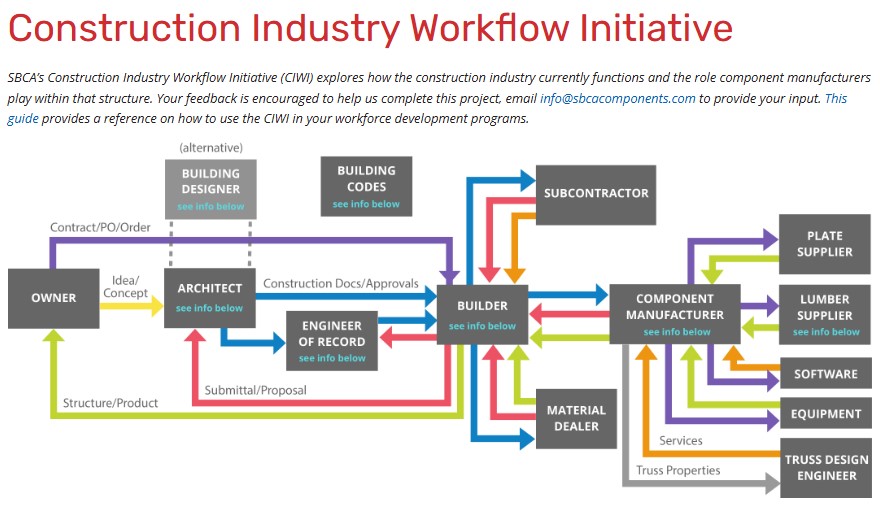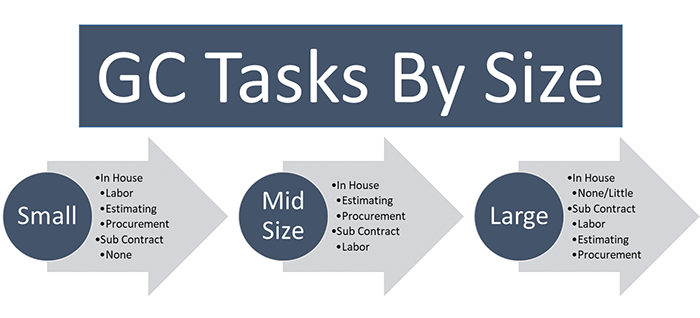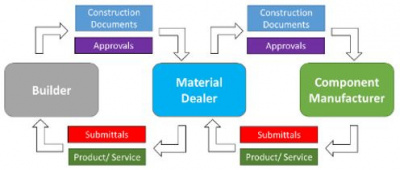CMs Now Have a Powerful New-Hire Training Tool
With the goal of spotlighting and illuminating, we published a series of articles that illustrate component manufacturers’ (CM) position within the construction industry supply chain and how information flows between all parties involved. SBCA’s Construction Industry Workflow Initiative (CIWI) shows the complicated information flow between parties and how the ensuing goods and services are used to ultimately build a structure, such as a single family home, commercial property or any type of structure within the building codes.
 At the heart of the CIWI is an interactive diagram (above) that illustrates the position of each stakeholder in the construction industry supply chain. Within each node on the diagram is a link to a summary article that further describes that entity’s role in the process.
At the heart of the CIWI is an interactive diagram (above) that illustrates the position of each stakeholder in the construction industry supply chain. Within each node on the diagram is a link to a summary article that further describes that entity’s role in the process.
Long time industry professionals can easily navigate the industry workflow, but that same navigation may prove difficult for those new to the component, or even the construction industry. As much as it is an industry exploratory project to understand the value of components to the construction industry, the CIWI can be a valuable workforce development tool. CMs (and their customers) are hiring new people every day. The CIWI is the perfect tool to orient new hires to the industry and help explain how various construction documents are developed, who impacts and makes decisions about those documents, and ultimately, how they arrive in the hands of CMs around the country.
The CIWI illustrates and explains how building codes implicate many decisions governing how a structure is built. It shows the relationship between the structure owner and the architect as well as the separate relationship an owner must forge with a builder or general contractor. The CIWI shows the importance of the role engineers play in the construction design process, along with the functions the builder fills coordinating subcontractors, material suppliers and CMs. Beyond the CM, CIWI shows the various suppliers that allow CMs to quickly produce reliable components as the best structural framing solution. These suppliers include connector plate manufacturers, lumber manufacturers, engineering service providers, software developers and production equipment manufacturers.
Beyond a workforce development tool, CIWI offers an opportunity for CMs to acknowledge and review their position in the construction supply chain. Within that review, CMs may see an opportunity to transform their position in the supply chain. A CM can evaluate ways to offer increased value to customers and capitalize on a market that places a high demand on their product due to field labor constraints. CIWI acts as a spring board for CMs to think critically about their businesses and how they can best serve their local markets.
It should be noted, the construction industry is very diverse and subject to local products and processes, which may differ slightly from this illustration. While every effort has been taken to incorporate the various nuances within each individual market, some unique market attributes were likely not addressed. Please reach out to the CIWI team to explain those differences and so they can be incorporated into the CIWI. One of the most valuable attributes of the digital delivery of the CIWI is its ability to easily adapt and reflect changes in the market or incorporate attributes in a particular local market as they are pointed out. SBCA encourages you to reach out to info@sbcacomponents.com to suggest improvements, address potential errors, or encourage exploration of additional aspects of the supply chain.




